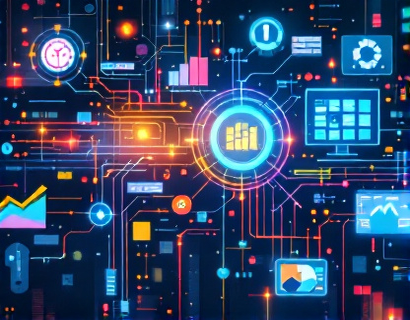AI-Powered Software: Revolutionizing Digital Business Growth Through Intelligent Automation and Data Insights
In the rapidly evolving digital landscape, businesses are increasingly turning to AI-powered software to gain a competitive edge. This transformative technology is not just a buzzword but a practical solution that enhances operational efficiency, drives strategic growth, and delivers actionable insights. The integration of artificial intelligence into digital business processes is revolutionizing the way companies operate, making it essential for any business aiming for success in the modern market.
The core of AI-powered software lies in its ability to automate repetitive and time-consuming tasks, freeing up human resources to focus on more strategic and creative aspects of the business. This automation extends beyond simple task execution; it involves intelligent processes that learn from data, adapt to new inputs, and perform tasks that traditionally required human intervention. By automating these processes, businesses can significantly reduce operational costs, minimize errors, and accelerate workflow.
Enhancing Operational Efficiency
One of the most immediate benefits of AI-powered software is the enhancement of operational efficiency. By automating routine tasks such as data entry, customer service inquiries, and inventory management, businesses can streamline their operations and reduce the time spent on these activities. This not only speeds up processes but also ensures consistency and accuracy, which are crucial for maintaining high standards of service and product quality.
For instance, in manufacturing, AI can optimize production schedules by analyzing real-time data on machine performance, material availability, and demand forecasts. This intelligent scheduling reduces downtime, minimizes waste, and maximizes resource utilization. In the service industry, chatbots powered by AI can handle a high volume of customer interactions, providing instant responses and resolving common issues without human intervention. This not only improves customer satisfaction but also allows human agents to focus on more complex and high-value tasks.
Data-Driven Decision Making
Another significant advantage of AI-powered software is its ability to deliver data-driven insights that inform strategic decision-making. Traditional business intelligence tools can process large volumes of data, but AI takes it a step further by analyzing this data to uncover patterns, trends, and insights that humans might miss. These insights can guide businesses in making informed decisions, identifying new opportunities, and mitigating risks.
For example, in the retail sector, AI can analyze customer purchase history, browsing behavior, and market trends to predict future demand and optimize inventory levels. This predictive analytics capability allows retailers to stock the right products at the right time, reducing overstock and understock issues. In finance, AI algorithms can detect fraudulent transactions by identifying unusual patterns in transaction data, enhancing security and protecting customer assets.
Personalization and Customer Experience
AI-powered software also plays a pivotal role in enhancing customer experiences through personalization. By leveraging data from various sources, AI can create detailed customer profiles that reflect individual preferences, behaviors, and needs. This information enables businesses to deliver personalized recommendations, tailored marketing messages, and customized user experiences, which can significantly boost customer engagement and loyalty.
In the e-commerce space, recommendation engines powered by AI analyze user behavior and purchase history to suggest products that are likely to interest the customer. This not only improves the shopping experience but also increases the likelihood of additional purchases. Similarly, in content delivery, AI can curate news feeds, entertainment recommendations, and news articles based on user preferences, keeping customers engaged and satisfied.
Case Study: Retail Personalization
A notable example of AI-driven personalization is seen in major e-commerce platforms. These platforms use AI to analyze vast amounts of user data, including search history, purchase history, and browsing behavior. Based on this analysis, AI algorithms generate personalized product recommendations, special offers, and content. For instance, a user who frequently purchases outdoor gear might receive targeted ads for new camping equipment or discounts on hiking boots. This level of personalization not only enhances the customer experience but also drives sales and customer retention.
Supply Chain Optimization
AI-powered software is also transforming supply chain management, a critical component of business operations. By integrating AI into supply chain processes, businesses can achieve greater visibility, predictability, and efficiency. AI algorithms can analyze data from various sources, including suppliers, logistics providers, and internal systems, to optimize every stage of the supply chain.
For example, AI can predict demand more accurately by analyzing historical sales data, market trends, and external factors such as weather and economic indicators. This predictive demand forecasting helps businesses adjust their production and inventory levels accordingly, reducing the risk of stockouts and excess inventory. Additionally, AI can optimize routing and scheduling for delivery trucks, minimizing transportation costs and delivery times. In warehousing, AI-powered robots and automated systems can streamline inventory management, picking, and packing processes, further enhancing efficiency.
Case Study: Supply Chain Resilience
A manufacturing company that implemented AI-driven supply chain solutions saw significant improvements in its operational resilience. By using AI to monitor and analyze data from suppliers and logistics partners, the company could proactively identify potential disruptions and take corrective actions. For instance, when a major supplier faced a production delay due to unforeseen circumstances, the AI system alerted the company, which then sourced alternative materials from other suppliers, ensuring minimal disruption to the production line. This level of agility and foresight is crucial in today’s volatile market environment.
Cybersecurity Enhancements
With the increasing reliance on digital technologies, cybersecurity has become a paramount concern for businesses. AI-powered software offers advanced security solutions that can detect and respond to threats in real-time, protecting sensitive data and maintaining business continuity. AI algorithms can analyze vast amounts of data to identify anomalies and patterns indicative of cyber threats, such as malware attacks, phishing attempts, and unauthorized access.
For example, AI-driven security systems can monitor network traffic and user activities, flagging suspicious behavior and automatically initiating countermeasures. This proactive approach to cybersecurity not only prevents potential breaches but also reduces the workload on IT security teams, allowing them to focus on strategic initiatives. Moreover, AI can continuously learn from new threats, adapting and improving its defenses over time.
Case Study: Proactive Threat Detection
A financial institution that adopted AI-powered cybersecurity solutions experienced a significant reduction in security incidents. The AI system continuously monitored transactions and user activities, detecting and blocking fraudulent activities in real-time. For instance, when a series of unusual login attempts were detected from different geographic locations, the AI system immediately locked the account and alerted the security team. This swift response prevented a potential data breach, safeguarding customer information and maintaining trust.
Challenges and Considerations
While the benefits of AI-powered software are undeniable, businesses must also be aware of the challenges and considerations involved in implementing these technologies. One of the primary concerns is the integration of AI systems with existing infrastructure. This requires careful planning and expertise to ensure seamless integration and optimal performance. Additionally, the quality and quantity of data used to train AI models are critical factors that can impact the accuracy and reliability of the insights generated.
Another consideration is the ethical use of AI, including issues related to data privacy, bias, and transparency. Businesses must adhere to ethical standards and regulatory requirements to build trust with customers and stakeholders. Investing in employee training and upskilling is also essential to ensure that the workforce can effectively leverage AI tools and adapt to new roles in an AI-driven environment.
Overcoming Integration Challenges
A tech firm that successfully integrated AI into its existing systems faced several challenges, including compatibility issues and data silos. To overcome these, the company conducted a thorough assessment of its current infrastructure and identified key integration points. They engaged with AI experts to develop custom solutions that could seamlessly connect with existing systems. Additionally, they invested in data governance practices to ensure high-quality, consistent data across all platforms. This strategic approach enabled the company to harness the full potential of AI while minimizing disruptions.
Future Trends and Opportunities
The future of AI-powered software in digital businesses looks promising, with ongoing advancements poised to unlock new opportunities and drive further innovation. One emerging trend is the integration of AI with other cutting-edge technologies such as the Internet of Things (IoT), 5G, and blockchain. These synergies can lead to more intelligent, connected, and secure business environments.
For instance, IoT devices can generate vast amounts of real-time data that AI can analyze to optimize operations and enhance decision-making. In smart cities, AI-powered IoT systems can monitor traffic, energy usage, and environmental conditions, enabling more efficient and sustainable urban management. Similarly, in the healthcare sector, AI combined with IoT can enable remote patient monitoring, predictive health analytics, and personalized treatment plans.
The Role of AI in Remote Work
The shift towards remote work has accelerated the adoption of AI-powered tools to maintain productivity and collaboration. AI-driven productivity software can automate routine tasks, manage schedules, and facilitate communication among distributed teams. Virtual assistants powered by AI can handle scheduling, reminders, and document management, allowing employees to focus on core tasks. Additionally, AI can enhance virtual meetings by providing real-time translation, transcription, and sentiment analysis, making remote collaboration more effective and inclusive.
A software development company that embraced remote work leveraged AI-powered tools to maintain high productivity levels. AI-driven project management tools helped streamline workflows, track progress, and ensure accountability among team members. Virtual assistants managed meetings and communications, reducing the administrative burden on employees. This not only maintained productivity but also fostered a collaborative and efficient remote work culture.
Conclusion
AI-powered software is more than just a technological advancement; it is a transformative force that is reshaping the digital business landscape. By automating processes, delivering data-driven insights, and enhancing customer experiences, AI enables businesses to operate more efficiently, make informed decisions, and drive strategic growth. As the technology continues to evolve, the potential for innovation and improvement is vast, offering endless opportunities for businesses to thrive in the competitive digital market.











































